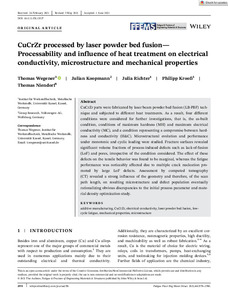| dc.date.accessioned | 2021-08-23T12:35:15Z | |
| dc.date.available | 2021-08-23T12:35:15Z | |
| dc.date.issued | 2021-06-16 | |
| dc.identifier | doi:10.17170/kobra-202108104523 | |
| dc.identifier.uri | http://hdl.handle.net/123456789/13152 | |
| dc.description.sponsorship | Gefördert im Rahmen des Projekts DEAL | ger |
| dc.language.iso | eng | eng |
| dc.rights | Attribution-NonCommercial-NoDerivatives 4.0 International | * |
| dc.rights.uri | http://creativecommons.org/licenses/by-nc-nd/4.0/ | * |
| dc.subject | additive manufacturing | eng |
| dc.subject | CuCrZr | eng |
| dc.subject | electrical conductivity | eng |
| dc.subject | laser powder bed fusion | eng |
| dc.subject | low-cycle fatigue | eng |
| dc.subject | mechanical properties | eng |
| dc.subject | microstructure | eng |
| dc.subject.ddc | 620 | |
| dc.subject.ddc | 660 | |
| dc.title | CuCrZr processed by laser powder bed fusion — Processability and influence of heat treatment on electrical conductivity, microstructure and mechanical properties | eng |
| dc.type | Aufsatz | |
| dcterms.abstract | CuCrZr parts were fabricated by laser beam powder bed fusion (LB-PBF) technique and subjected to different heat treatments. As a result, four different conditions were considered for further investigations, that is, the as-built condition, conditions of maximum hardness (MH) and maximum electrical conductivity (MC), and a condition representing a compromise between hardness and conductivity (H&C). Microstructural evolution and performance under monotonic and cyclic loading were studied. Fracture surfaces revealed significant volume fractions of process-induced defects such as lack-of-fusion (LoF) and pores, irrespective of the condition considered. The effect of these defects on the tensile behavior was found to be marginal, whereas the fatigue performance was noticeably affected due to multiple crack nucleation promoted by large LoF defects. Assessment by computed tomography (CT) revealed a strong influence of the geometry and therefore, of the scan path length, on resulting microstructure and defect population eventually rationalizing obvious discrepancies to the initial process parameter and material density optimization study. | eng |
| dcterms.accessRights | open access | |
| dcterms.creator | Wegener, Thomas | |
| dcterms.creator | Koopmann, Julian | |
| dcterms.creator | Richter, Julia | |
| dcterms.creator | Krooß, Philipp | |
| dcterms.creator | Niendorf, Thomas | |
| dc.relation.doi | doi:10.1111/ffe.13527 | |
| dc.subject.swd | Selektives Laserschmelzen | ger |
| dc.subject.swd | Rapid Prototyping <Fertigung> | ger |
| dc.subject.swd | Kupfer | ger |
| dc.subject.swd | Chrom | ger |
| dc.subject.swd | Zirkonium | ger |
| dc.subject.swd | Elektrische Leitfähigkeit | ger |
| dc.subject.swd | Ermüdung bei niedrigen Lastspielzahlen | ger |
| dc.subject.swd | Mechanische Eigenschaft | ger |
| dc.subject.swd | Mikrostruktur | ger |
| dc.type.version | publishedVersion | |
| dcterms.source.identifier | eissn:1460-2695 | |
| dcterms.source.issue | Issue 9 | |
| dcterms.source.journal | Fatigue & Fracture of Engineering Materials & Structures (FFEMS) | eng |
| dcterms.source.pageinfo | 2570-2590 | |
| dcterms.source.volume | Volume 44 | |
| kup.iskup | false | |


